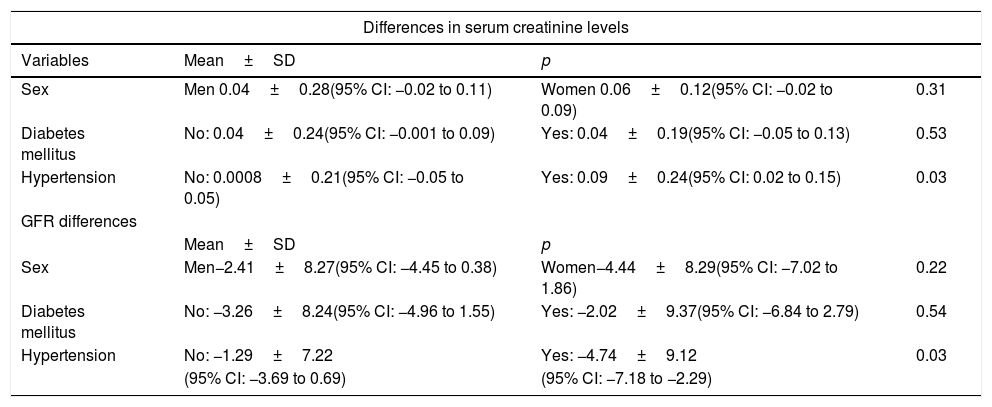The term contrast-induced nephropathy is used to describe acute deterioration of renal function after the intravenous administration of iodinated contrast material. We aimed to estimate the incidence of contrast-induced nephropathy and to analyze the evolution of different biomarkers of renal function in patients who underwent computed tomography with intravenous contrast administration after premedication with oral hydration and N-acetylcysteine.
Material and methodsThis prospective observational study included 112 patients with chronic renal failure (glomerular filtration rate (GFR) 30ml–60ml/min/1.73m2) scheduled for computed tomography with intravenous iodinated contrast material. We recorded demographic variables, dose of contrast material, diabetes mellitus, hypertension, and serum hemoglobin. We measured serum creatinine and GFR after premedication and after the CT examination. We summarized variables as means, standard deviations, and percentages. We used the Wilcoxon and Mann–Whitney tests to compare pre- and post-CT values and Pearson's r to analyze correlations.
ResultsIncidence acute kidney injury: 0.9%; 95%CI: 0.36–1.4. Mean difference between pre- and post-CT creatinine: 0.04; 95%CI: 0.002–0.09, p<0.004. Mean difference between pre- and post-CT GFR: −3.06; 95%CI: −4.66 to −1.47), p<0.001.
ConclusionsThe incidence of contrast-induced nephropathy in patients with chronic renal failure and GFR 30ml–60ml/min/1.73m2 is low. The biomarkers of renal function analyzed improve in patients who receive premedication and the minimum dose of contrast material.
Nefropatía inducida por contraste (NIC) es el deterioro agudo de la función renal tras la administración intravascular de contraste yodado. Nuestros objetivos son estimar la incidencia de NIC y analizar la evolucion de distintos biomarcadores de funcion renal, en pacientes tras una tomografía computarizada (TC) con contraste yodado intravenoso (CIV) y premedicación (hidratación oral y N-acetilcisteína).
Material y métodosEstudio observacional prospectivo. Fueron seleccionados 112 pacientes, con una TC con CIV programada y enfermedad renal crónica (ERC) con un filtrado glomerular (FG) entre 30 y 60ml/min/1,73 m2. Se obtuvieron datos demográficos, dosis del CIV, diabetes mellitus, hipertensión arterial y hemoglobina sérica. Se midió la creatinina sérica y el FG posterior a la premedicación y a la TC. Se utilizaron medias, desviaciones estándar y porcentajes, así como las pruebas de Wilcoxon y Mann-Whitney para determinar diferencias significativas, y la de Pearson para análisis de correlación.
ResultadosIncidencia de insuficiencia renal aguda: 0,9%; intervalo de confianza (IC) 95%: 0,36 a 1,4. Media de la diferencia de creatinina pre- y post-TC: 0,04 (IC: 0,002 a 0,09), p < 0,004. Media de la diferencia de FG pre- y post-TC: -3,06 (IC: -4,66 a -1,47), p < 0,001.
ConclusionesLa incidencia de NIC en pacientes con ERC y FG entre 30 y 60ml/min/1,73 m2 es baja. Los pacientes que recibieron premedicación y la mínima dosis de CIV presentaron mejoría en los biomarcadores de función renal analizados.










